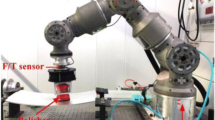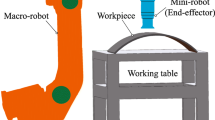Abstract
Process monitoring is essential to enable process parameter optimization, deformation prediction, and fault diagnosis in robotic milling. However, expensive costs and installation requirements limit the use of industrial sensors in machining process. This paper proposed a sensorless method to predict force-induced deformation and surface waviness. First, the tracking errors of tooltip was calculated based on the robot joint tracking errors and the robot kinematic model. Subsequently, the idle running and cutting process signals monitored by the robot controller were used to calculate the cutting force acting on tooltip based on Kalman filter and robot static model. On this base, the force-induced deformation, considering the posture error of the robot flange coordinate system, was calculated using the estimated milling force and the flexible model. Finally, the effectiveness of the proposed method was verified by a series of cutting experiments.
















Similar content being viewed by others
Data availability
The publication-related datasets are available from the corresponding author on reasonable request.
Abbreviations
- \({T}_{\textrm{fl}}^{\textrm{base}}\) :
-
The transformation from RBCS to RFCS
- θ i :
-
Joint angle around z-axis
- a i :
-
The angle measured around the x-axis
- d i :
-
Slide distance along the z-axis
- a i :
-
The distance along the x-axis
- \({T}_{\textrm{wp}}^{\textrm{base}}\) :
-
The transformation from RBCS to WCS
- \({P}_{\textrm{tool}}^{\textrm{fl}}\) :
-
The coordinate value of TCP in the RFCS
- M(q):
-
The inertia matrix of the robot
- G(q):
-
The gravity matrix of the robot
- \(C\left(q,\dot{q}\right)\) :
-
The centrifugal and Coriolis effects
- τm :
-
The total joint torque during milling process
- τf :
-
Joint torque caused by friction
- τ ext :
-
Joint torque caused by cutting force (cutting torque)
- \(\overline{\tau}\) :
-
The total joint torque of idle running
- x(t):
-
State vector
- y(t):
-
Output vector, estimated cutting torque
- u(t):
-
Input vector, measured cutting torque
- L :
-
Kalman gain matrix
- P :
-
Covariance matrix
- Q :
-
The covariance of process noise
- R :
-
The covariance of measurement noise
- J :
-
Jacobi matrix of the robot
- F fl :
-
The external force acting in RFCS
- F tool :
-
The cutting force acting on tooltip
- \({R}_{\textrm{tool}}^{\textrm{fl}}\) :
-
The transformation from RFCS to TCS
- PI i :
-
The observability index of the ith joint
- τ cut, i :
-
The cutting torque of the ith joint
- τ move, i :
-
The idle-running torque of the ith joint
- τ ext, m :
-
The n × 1 (n ≥ 3) joint cutting torque matrix
- \({J}_{\textrm{m}}^T\) :
-
The n × 6 generalized Jacobi matrix
- δ fcp :
-
The force-induced deformation in the RFCS
- C θ :
-
The robot joint flexibility matrix
- K θ :
-
The robot joint stiffness matrix
- δ tool :
-
The deformation of tooltip
References
Verl A, Valente A, Melkote S et al (2019) Robots in machining. CIRP Annals 68(2):799–822. https://doi.org/10.1016/j.cirp.2019.05.009
Deng K, Gao D, Zhao C, Yong L (2023) Prediction of in-process frequency response function and chatter stability considering pose and feedrate in robotic milling. Robot Comput Integr Manuf 82:102548. https://doi.org/10.1016/j.rcim.2023.102548
**ong G, Li ZL, Ding Y, Zhu L (2020) Integration of optimized feedrate into an online adaptive force controller for robot milling. Int J Adv Manuf Technol 106(3):1533–1542. https://doi.org/10.1007/s00170-019-04691-1
Cen L, Melkote SN, Castle J, Howard A (2016) A wireless force-sensing and model-based approach for enhancement of machining accuracy in robotic milling. IEEE ASME Trans Mechatron 21(5):2227–2235. https://doi.org/10.1109/TMECH.2016.2567319
Wojciechowski S, Matuszak M, Powałka B, Madajewski M, Maruda RW, Królczyk GM (2019) Prediction of cutting forces during micro end milling considering chip thickness accumulation. Int J Mach Tools Manuf 147:103466. https://doi.org/10.1016/j.ijmachtools.2019.103466
Wojciechowski S, Maruda RW, Krolczyk GM, Niesłony P (2018) Application of signal to noise ratio and grey relational analysis to minimize forces and vibrations during precise ball end milling. Precis Eng 51:582–596. https://doi.org/10.1016/j.precisioneng.2017.10.014
Wojciechowski S, Wiackiewicz M, Krolczyk GM (2018) Study on metrological relations between instant tool displacements and surface roughness during precise ball end milling. Measurement 129:686–694. https://doi.org/10.1016/j.measurement.2018.07.058
Denkena B, Lepper T (2015) Enabling an industrial robot for metal cutting operations. Procedia CIRP 35:79–84. https://doi.org/10.1016/j.procir.2015.08.100
Zhang P, Gao D, Lu Y, Wang F, Liao Z (2022) A novel smart toolholder with embedded force sensors for milling operations. Mech Syst Signal Process 175:109130. https://doi.org/10.1016/j.ymssp.2022.109130
Gonzalez MK, Theissen NA, Barrios A, Archenti A (2022) Online compliance error compensation system for industrial manipulators in contact applications. Robot Comput Integr Manuf 76:102305. https://doi.org/10.1016/j.rcim.2021.102305
Stürz YR, Affolter LM, Smith RS (2017) Parameter identification of the KUKA LBR iiwa robot including constraints on physical feasibility. IFAC-PapersOnLine 50(1):6863–6868
Wahrburg A, Bös J, Listmann KD, Dai F, Matthias B, Ding H (2017) Motor-current-based estimation of cartesian contact forces and torques for robotic manipulators and its application to force control. IEEE Trans Autom Sci Eng 15(2):879–886. https://doi.org/10.1109/TASE.2017.2691136
Zhang S, Wang S, **g F, Tan M (2019) A sensorless hand guiding scheme based on model identification and control for industrial robot. IEEE Trans Industr Inform 15(9):5204–5213. https://doi.org/10.1109/TII.2019.2900119
Liu S, Wang L, Wang XV (2021) Sensorless force estimation for industrial robots using disturbance observer and neural learning of friction approximation. Robot Comput Integr Manuf 71:102168. https://doi.org/10.1016/j.rcim.2021.102168
Huang J, Zhang M, Ri S, **ong C, Li Z, Kang Y (2019) High-order disturbance-observer-based sliding mode control for mobile wheeled inverted pendulum systems. IEEE Trans Ind Electron 67(3):2030–2041. https://doi.org/10.1109/TIE.2019.2903778
Bittencourt AC, Axelsson P (2013) Modeling and experiment design for identification of wear in a robot joint under load and temperature uncertainties based on friction data. IEEE ASME Trans Mechatron 19(5):1694–1706. https://doi.org/10.1109/TMECH.2013.2293001
Bittencourt AC, Gunnarsson S (2012) Static friction in a robot joint—modeling and identification of load and temperature effects. J Dyn Syst Meas Control 134(5). https://doi.org/10.1115/1.4006589
Yang K, Yang W, Cheng G, Lu B (2018) A new methodology for joint stiffness identification of heavy duty industrial robots with the counterbalancing system. Robot Comput Integr Manuf 53:58–71. https://doi.org/10.1016/j.rcim.2018.03.001
Stavropoulos P, Bikas H, Souflas T, Ghassempouri M (2021) A method for cutting force estimation through joint current signals in robotic machining. Procedia Manuf 55:124–131. https://doi.org/10.1016/j.promfg.2021.10.018
Abele E, Weigold M, Rothenbücher S (2007) Modeling and identification of an industrial robot for machining applications. CIRP annals 56(1):387–390. https://doi.org/10.1016/j.cirp.2007.05.090
Bu Y, Liao W, Tian W, Zhang J, Zhang L (2017) Stiffness analysis and optimization in robotic drilling application. Precis Eng 49:388–400. https://doi.org/10.1016/j.precisioneng.2017.04.001
Yue C, Gao H, Liu X, Liang SY (2018) Part functionality alterations induced by changes of surface integrity in metal milling process: a review. Appl Sci 8(12):2550. https://doi.org/10.3390/app8122550
Grzesik W (2008) Advanced machining processes of metallic materials: theory, modeling and applications. Elsevier
Furtado LFF, Villani E, Trabasso LG, Suterio R (2017) A method to improve the use of 6-dof robots as machine tools. Int J Adv Manuf Technol 92(5):2487–2502. https://doi.org/10.1007/s00170-017-0336-8
Ahrens M, Fischer R, Dagen M, Denkena B, Ortmaier T (2013) Abrasion monitoring and automatic chatter detection in cylindrical plunge grinding. Procedia CIRP 8:374–378. https://doi.org/10.1016/j.procir.2013.06.119
Nasir V, Cool J, Sassani F (2019) Acoustic emission monitoring of sawing process: artificial intelligence approach for optimal sensory feature selection. Int J Adv Manuf Technol 102(9):4179–4197. https://doi.org/10.1007/s00170-019-03526-3
Liu C, Gao L, Wang G, Xu W, Jiang X, Yang T (2020) Online reconstruction of surface topography along the entire cutting path in peripheral milling. Int J Mech Sci 185:105885. https://doi.org/10.1016/j.ijmecsci.2020.105885
Schreoder K (1999) Handbook of industrial robotics. John Wiley & Sons. https://doi.org/10.1002/9780470172506
Deng K, Gao D, Ma S, Zhao C (2023) Elasto-geometrical error and gravity model calibration of an industrial robot using the same optimized configuration set. Robot Comput Integr Manuf 83:102558. https://doi.org/10.1016/j.rcim.2023.102558
Aslan D, Altintas Y (2018) Prediction of cutting forces in five-axis milling using feed drive current measurements. IEEE ASME Trans Mechatron 23(2):833–844. https://doi.org/10.1109/TMECH.2018.2804859
Chen Y, Lu J, Deng Q, Ma J, Liao X (2022) Modeling study of milling force considering tool runout at different types of radial cutting depth. J Manuf Process 76:486–503. https://doi.org/10.1016/j.jmapro.2022.02.037
Yue C, Gao H, Liu X, Liang SY (2019) A review of chatter vibration research in milling. Chinese J Aeronaut 32(2):215–242. https://doi.org/10.1016/j.cja.2018.11.007
Code availability
Not applicable.
Funding
This work was supported by National Key Research and Development Project of China (2018YFB1306803).
Author information
Authors and Affiliations
Contributions
K. N. D., Y. L., and D. G. conceived and designed the study. K. N. D. and S. D. M. performed the experiments. K. N. D. and C. Z. wrote the paper. K. N. D., Y. L., and D. G. reviewed and edited the manuscript. All authors read and approved the manuscript.
Corresponding authors
Ethics declarations
Ethics approval
Not applicable.
Consent to participate
Not applicable.
Consent for publication
All authors approved the manuscript and gave their consent for submission and publication.
Competing interests
The authors declare no competing interests.
Additional information
Publisher’s note
Springer Nature remains neutral with regard to jurisdictional claims in published maps and institutional affiliations.
Rights and permissions
Springer Nature or its licensor (e.g. a society or other partner) holds exclusive rights to this article under a publishing agreement with the author(s) or other rightsholder(s); author self-archiving of the accepted manuscript version of this article is solely governed by the terms of such publishing agreement and applicable law.
About this article
Cite this article
Deng, K., Gao, D., Zhao, C. et al. A sensorless method for predicting force-induced deformation and surface waviness in robotic milling. Int J Adv Manuf Technol 127, 831–844 (2023). https://doi.org/10.1007/s00170-023-11559-y
Received:
Accepted:
Published:
Issue Date:
DOI: https://doi.org/10.1007/s00170-023-11559-y




